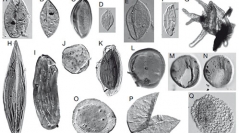

 Geodiversitas
33 (1) - Pages 137-176
Geodiversitas
33 (1) - Pages 137-176Detailed records of spore-pollen assemblages from four sites located in the Aliaga and Oliete Sub-basins provide new insights into the palaeoclimatic and palaeogeographic settings during the Albian-Cenomanian transition in the Maestrazgo Basin (northeastern Spain). Palynological taxa such as Afropollis jardinus Doyle, Jardiné & Doerenkamp, 1982, Elaterosporites klaszii (Jardiné & Magloire) Jardiné, 1967, Equisetosporites ambiguus (Hedlund 1966) Singh, 1983, Gabonisporis pseudoreticulatus Boltenhagen, 1967, Senectotetradites varireticulatus Dettmann, 1973, Stellatopollis barghoornii Doyle, 1975, and the dinoflagellate cyst Cyclonephelium chabaca Below, 1981 indicate a latest Albian age for this unit. Abundance of Gondwanan elements such as Afropollis Doyle, Jardiné & Doerenkamp, 1982, Elaterosporites Jardiné, 1967 and Stellatopollis Doyle, 1975 indicates a northward extension of the paleogeographic distributions of those taxa during this time. Comparison between the studied microflora of the Iberian Range and microfloras from Tethyan and Gondwanan realms allows better understanding of the Tethyan paleogeographic setting.
Palynology, Lower Cretaceous, Albian-Cenomanian boundary, paleophytogeography